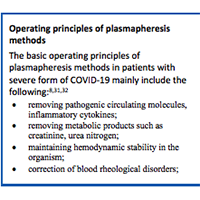 Smart Citations
Smart CitationsSee how this article has been cited at scite.ai
scite shows how a scientific paper has been cited by providing the context of the citation, a classification describing whether it supports, mentions, or contrasts the cited claim, and a label indicating in which section the citation was made.
Prospects of plasmapheresis for patients with severe COVID-19
On February 11, 2020, the World Health Organization officially named the infection caused by the new coronavirus “Coronavirus disease 2019” (COVID-19). On February 11, 2020, the International Committee on Taxonomy of Viruses (ICTV) officially named the infectious matter “severe acute respiratory syndrome coronavirus 2” (SARS-CoV-2). Emergence of severe complications with new coronavirus disease is due to the development of hypercytokinaemia, also known as “cytokine storm”. These complications comprise acute respiratory distress syndrome (ARDS), respiratory failure and death. Emerging data point to the logic of using extracorporeal haemocorrection to normalise cytokine levels and reduce the severity of organ disorders. The analysis of the literature indicates that to date, a certain positive experience has been accumulated in the world in the application of extracorporeal methods in clinical practice in patients with COVID-19.
Downloads
How to Cite
PAGEPress has chosen to apply the Creative Commons Attribution NonCommercial 4.0 International License (CC BY-NC 4.0) to all manuscripts to be published.

 https://doi.org/10.4081/ejtm.2020.9165
https://doi.org/10.4081/ejtm.2020.9165





